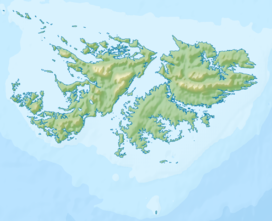Mount Usborne: Difference between revisions
Content deleted Content added
No edit summary |
Rescuing 1 sources and tagging 0 as dead. #IABot (v1.6.2) |
||
| Line 38: | Line 38: | ||
==External links== |
==External links== |
||
* [http://www.falklands.info/background/strollusborne.html A Stroll up Mount Usborne] |
* [https://web.archive.org/web/20051210050328/http://www.falklands.info/background/strollusborne.html A Stroll up Mount Usborne] |
||
* {{webarchive |url=https://web.archive.org/web/20101223043232/http://www.oceandots.com/atlantic/falklands/mount-usborne.php |date=December 23, 2010 |title=Satellite picture of Mount Usborne }} |
* {{webarchive |url=https://web.archive.org/web/20101223043232/http://www.oceandots.com/atlantic/falklands/mount-usborne.php |date=December 23, 2010 |title=Satellite picture of Mount Usborne }} |
||
Revision as of 00:10, 7 February 2018
| Mount Usborne | |
|---|---|
| Highest point | |
| Elevation | 2,313 ft (705 m)[1] |
| Prominence | 2,313 ft (705 m)[1] |
| Coordinates | 51°41′50″S 58°50′04″W / 51.69722°S 58.83444°W |
| Geography | |
| Location | East Falkland, Falkland Islands, south Atlantic Ocean |
| Parent range | Wickham Heights |
Mount Usborne (Spanish: Cerro Alberdi) is a mountain on East Falkland. At 2,313 feet (705 m) above sea level, it is the highest point in the Falkland Islands.
The mountain is referenced by Charles Darwin in Chapter 9 of the Zoology of the Voyage of the Beagle and is named after Alexander Burns Usborne[2], Master's Assistant on HMS Beagle, the ship that took Darwin on his famous voyage.
The remains of glacial cirques can also be seen on Mount Usborne. It is only a few metres taller than Mount Adam, the highest peak on West Falkland.
As one of the highest mountains of the Falklands, it experienced some glaciation. The handful of mountains over 2,000 feet (610 m) have:
- "pronounced corries with small glacial lakes at their bases, morainic ridges deposited below the corries suggest that the glaciers and ice domes were confined to areas of maximum elevation with other parts of the islands experiencing a periglacial climate" [3]
References
- Stonehouse, B (ed.) Encyclopedia of Antarctica and the Southern Oceans (2002, ISBN 0-471-98665-8)
- ^ a b "Mount Usborne, Falkland Islands". Peakbagger.com. Retrieved 2014-08-03.
- ^ Alexander Burns Usborne
- ^ Strange, Ian (1983) The Falkland Islands
External links
- A Stroll up Mount Usborne
- Satellite picture of Mount Usborne at the Wayback Machine (archived December 23, 2010)

